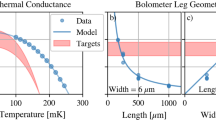Abstract
In the next decade, new ground-based cosmic microwave background (CMB) experiments such as Simons Observatory, CCAT-prime, and CMB-S4 will increase the number of detectors observing the CMB by an order of magnitude or more, dramatically improving our understanding of cosmology and astrophysics. These projects will deploy receivers with as many as hundreds of thousands of transition edge sensor (TES) bolometers coupled to superconducting quantum interference device (SQUID)-based readout systems. It is well known that superconducting devices such as TESes and SQUIDs are sensitive to magnetic fields. However, the effects of magnetic fields on TESes are not easily predicted due to the complex behavior of the superconducting transition, which motivates direct measurements of the magnetic sensitivity of these devices. We present comparative four-lead measurements of the critical temperature versus applied magnetic field of AlMn TESes varying in geometry, doping, and leg length, including Advanced ACT and POLARBEAR-2/Simons Array bolometers. MoCu ACTPol TESes are also tested and are found to be more sensitive to magnetic fields than the AlMn devices. We present an observation of weak-link-like behavior in AlMn TESes at low critical currents. We also compare measurements of magnetic sensitivity for time division multiplexing SQUIDs and frequency division multiplexing microwave (\(\mu \)MUX) rf-SQUIDs. We discuss the implications of our measurements on the magnetic shielding required for future experiments that aim to map the CMB to near-fundamental limits.




Similar content being viewed by others
References
J.W. Fowler et al., Appl. Opt. 46, 3444 (2007). https://doi.org/10.1364/AO.46.003444
K Harrington et al., Proc. SPIE Int. Soc. Opt. Eng. 9914, 99141K (2016). https://doi.org/10.1117/12.2233125
K. Arnold et al., Proc. SPIE 8452, 84521D (2012). https://doi.org/10.1117/12.927057
K.N. Abazajian et al., ArXiv e-prints 1610, 02743 (2016)
S.W. Deiker et al., Appl. Phys. Lett. 85(11), 2137 (2004). https://doi.org/10.1063/1.1789575
S.W. Henderson et al., J. Low Temp. Phys. 184(3–4), 772 (2015). https://doi.org/10.1007/s10909-016-1575-z
S.M. Duff et al., J Low Temp Phys 184(3), 634 (2016). https://doi.org/10.1007/s10909-016-1576-y
M.H. Abitbol et al., ArXiv e-prints 1706, 02464 (2017)
T.M. Lanting et al., Appl. Phys. Lett. 86, 112511 (2005)
K.D. Irwin, K.W. Lehnert, Appl. Phys. Lett. 85, 2107 (2004)
J.A.B. Mates, G.C. Hilton, K.D. Irwin, L.R. Vale, K.W. Lehnert, Appl. Phys. Lett. 92, 023514 (2008)
R.J. Thornton et al., Proc. SPIE 7020, 7020 (2008). https://doi.org/10.1117/12.790078
J.T. Ward et al., Proc. SPIE 9914, 991437 (2016). https://doi.org/10.1117/12.2233746
E.E. Quealy, Ph.D. thesis, University of California, Berkeley (2012)
E. Grace et al., J. Low Temp. Phys. 176(5–6), 705 (2014). https://doi.org/10.1007/s10909-014-1125-5
A. Suzuki et al., J. Low Temp. Phys. 184, 805 (2016). https://doi.org/10.1007/s10909-015-1425-4
D. Li et al., J. Low Temp. Phys. 184, 66 (2016). https://doi.org/10.1007/s10909-016-1526-8
D.R. Schmidt et al., IEEE Trans. Appl. Supercond. 21(3), 196 (2011). https://doi.org/10.1109/TASC.2010.2090313
J.E. Sadleir et al., Phys. Rev. Lett. 104(4), 047003 (2010). https://doi.org/10.1103/PhysRevLett. 104.047003
Sadleir, J.E., Superconducting transition-edge sensor physics, Ph.D. Thesis, University of Illinois (2010)
S.J. Smith et al., J. Appl. Phys. 114(7), 074513–074513-24 (2013). https://doi.org/10.1063/1.4818917
J.N. Ullom, D.A. Bennett, Supercond. Sci. Technol. 28(8), 084003 (2015). https://doi.org/10.1088/0953-2048/28/8/084003
S.W. Henderson et al., Proc. SPIE 9914, 99141G (2016). https://doi.org/10.1117/12.2233895
M.D. Niemack, Towards Dark Energy: Design, Development, and Preliminary Data from ACT, Ph.D. Thesis, Princeton University (2008)
S.-P.P. Ho et al., Proc. SPIE 9914, 9914 (2017). https://doi.org/10.1117/12.2233113
E.A. Grace, Ph.D. thesis, Princeton University (2016)
A. Suzuki, Ph.D. thesis, University of California, Berkeley (2013)
B.K. et al., J. Low Temp. Phys. This Special Issue LTD17 (2018). https://doi.org/10.1007/s10909-018-1957-5
M.D. Audley et al., Proc. SPIE 5498, 63 (2004). https://doi.org/10.1117/12.551259
Acknowledgements
The authors thank Christine Pappas for useful discussions of weak-link-like behavior in AlMn TESes, Zeqi Gu for assistance in measuring magnetic shielding values, and Suzanne Staggs, Edward Wollack, and Kevin Crowley for their helpful comments and feedback which have improved this work. The authors also thank the Atacama Cosmology Telescope, Simons Array, and Simons Observatory collaborations for their contributions, including the development of the detectors tested in this paper. This work was supported by NSF Grant AST-1454881. EMV was supported by the NSF GRFP under Grant No. DGE-1650441.
Author information
Authors and Affiliations
Corresponding author
Rights and permissions
About this article
Cite this article
Vavagiakis, E.M., Henderson, S.W., Zheng, K. et al. Magnetic Sensitivity of AlMn TESes and Shielding Considerations for Next-Generation CMB Surveys. J Low Temp Phys 193, 288–297 (2018). https://doi.org/10.1007/s10909-018-1920-5
Received:
Accepted:
Published:
Issue Date:
DOI: https://doi.org/10.1007/s10909-018-1920-5




